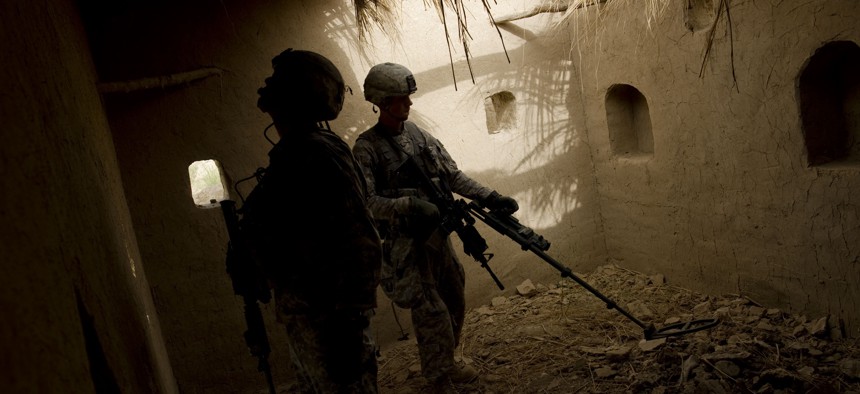How to Think About Counterinsurgency After Afghanistan
Realistic policy depends on a closer look at costs, benefits, and the objectives of would-be counterinsurgency partners.
President Joe Biden’s recent announcement that all U.S. military forces would leave Afghanistan this year drew immediate criticism from a wide range of national security experts and elected officials. Some of this reflected fear of a human rights disaster if the Afghan government is unable to hold out against the Taliban once the American military leaves. But most of the pushback was based on the claim that the U.S. counterinsurgency campaign in Afghanistan is vital for preventing another major terrorist attack on the United States. The pervasiveness of this idea demonstrates that after sixty years of involvement in counterinsurgency, Americans still don’t truly understand it.
The first mistake leading the United States to a quagmire in Afghanistan was linking counterinsurgency and counterterrorism. When the United States became involved in counterinsurgency during the Cold War, it did so to prevent pro-Soviet rebels from seizing power in friendly nations. After the Soviet Union collapsed, the United States lost interest. Following the 9/11 attacks, the United States rediscovered counterinsurgency. This time, however, the objective was preventing transnational terrorists from gaining foreign sanctuary. It was, as former President George W. Bush put it, a way “to defeat them abroad before they attack us at home.” Based on this claim, the United States undertook counterinsurgency support in Iraq, Afghanistan, and, on a smaller scale, in a host of other places in the Islamic world.
Forged in the emotional time after the attacks on the United States, this never made strategic sense. While al Qaeda did have sanctuary in Afghanistan in 2001, no one demonstrated that it was necessary to plan the attack. And even if it was, no one fully explained why a base in Afghanistan was more important to al Qaeda than any of the dozen other places where it could operate. Ultimately, the argument that counterinsurgency in Afghanistan was necessary to prevent another terrorist attack on the United States was simply asserted, never explained or substantiated.
For years, the American public was so shocked by the attacks that it did not question this. Over time, though, credibility of the assertion eroded. Today, it seems clear that even if counterinsurgency does somehow help fight terrorist groups, the security gained does not justify the costs. Counterinsurgency may contribute to counterterrorism, but it does so very inefficiently.
The second mistake that Americans have made is assuming that counterinsurgency partners share their objectives. To be precise, the United States doesn’t undertake counterinsurgency but counterinsurgency support. The idea is to support a partner government with security assistance, economic help, and advice until it can handle insurgents with little or no external help. Unfortunately, America’s counterinsurgency partners often see the world differently. For many of them, control of the most vital parts of their country—the major cities and resource producing regions—is enough. Exercising full control over the hinterlands where insurgents often take root is not worth the effort. And while partner regimes certainly want to stave off military defeat by insurgents, they are often unwilling to undertake the deep reform needed to eliminate the injustice, inequity, repression, corruption, or exclusion that fueled the insurgency in the first place. Put bluntly, the U.S. approach to counterinsurgency expects America’s security partners to alter a political and economic system which directly benefits those holding power. Then the United States is surprised when they do not do so.
Afghanistan is a perfect illustration of America’s flawed understanding of counterinsurgency. The people with the power to end the pervasive corruption that leads some Afghans to tolerate or support the Taliban are those who profit from it. Moreover, the Afghan elite knows that even if it could eradicate the Taliban, it would not be in its interest to do so, since most of the outside assistance that keeps the nation afloat would dry up. Afghanistan today is built on a war economy. Both the Taliban and the national elite benefit from it. So long as that persists, so too will the conflict. Another decade of direct American involvement will not change that tragic dynamic.
How then should the United States think about counterinsurgency? In a word, realistically. First, Americans should admit that today’s terrorists do not need physical sanctuary, so trying to control every isolated patch of territory on earth is not worth the cost even if it could be done. Second, as heartbreaking as it would be to see evil movements like the Taliban, the Islamic State, or al Qaeda in control of all or part of a nation, the United States must base counterinsurgency support on the viability of the partner government, not the pathology of the insurgents. If a government is truly dedicated to altering the system that gave rise to insurgency and shares basic American values, it might deserve help. Otherwise, the United States should resist supporting a deeply flawed partner simply because its opponent is worse. This may ultimately be the most important strategic lesson of Afghanistan.
Steven Metz is professor of national security affairs and strategy at the U.S. Army War College. The ideas in this essay are solely the author’s and do not represent the official position of the U.S. Army or U.S. Army War College.
NEXT STORY: China to US: Back Off and Calm Down





